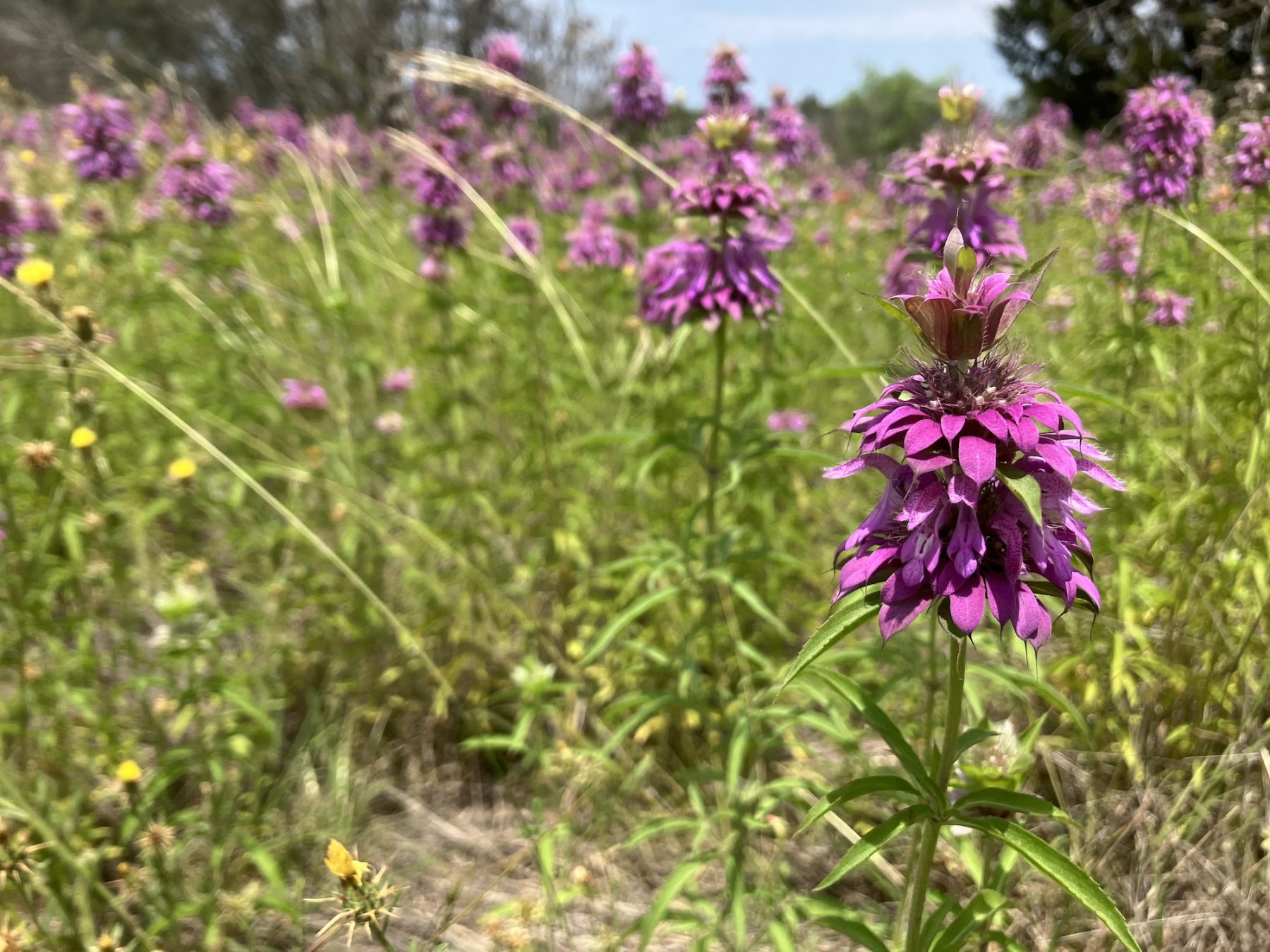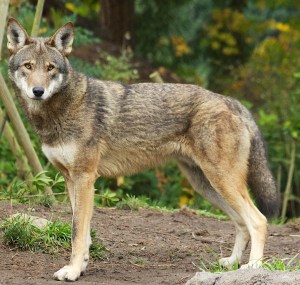How One Photo Of A Flower Reignited A Species Debate
A new photo of a long-forgotten flower showed up online. Identifying it means getting into the tricky question of how a species is defined.

A population of lemon beebalm (Monarda citriodora) flowering on the roadside near Austin, Texas. Credit: Patrick McKenzie
Dr. Patrick McKenzie, an evolutionary biologist at Harvard University, was perusing the internet late one night in January when he found a mysterious botanical specimen.
He was using iNaturalist, an app that allows users to upload photos and identify living things, to look for plants in the Monarda genus across northern Mexico. He was mostly finding records of Monarda citriodora, commonly known as lemon beebalm, but McKenzie noticed a few photos from farther south than usual. Strange observations like these tend to be mislabeled plants or garden specimens. But McKenzie found one photo he couldn’t explain—a wild specimen growing in Durango, Mexico, high in the forests of the Sierra Madre Occidental.
He wasn’t convinced it was M. citriodora. Rather, he concluded the sample fit the description of a different plant in the Monarda genus: Monarda mexicana, a species that currently has zero sightings on iNaturalist. As far as McKenzie knew, M. mexicana hadn’t been documented since 1952.

But some scientists argue that M. mexicana might not be a distinct species at all. As with many other plants and animals, the genus Monarda is rife with subspecies and varieties. It’s hard to draw the line between one distinct species and the next.
“I think if Monarda mexicana is a real species, then the iNaturalist observation I’m excited about is almost definitely an example,” McKenzie said in an email. “But there has never really been enough research to show whether it’s a “good” (i.e. “real”) species in the first place.”
Scientists have grappled with what they call the “species problem” for more than 150 years, but the question of how to define a species looms as climate change and habitat loss decimate biodiversity, urging researchers toward a more thorough inventory of the world’s living things. After all, if you don’t know what you have, it’s impossible to know what you’re losing. Confusion about what demarcates a single species can make conservation difficult and imprecise, and it can impact decisions about how and where to allocate funding. If scientists can’t differentiate between species, how will they decide which ones to protect?
To distinguish one creature from the next, researchers use tests called species concepts to study physical differences, evolutionary similarities, and genetic makeup. These tests frequently yield counterintuitive conclusions. For example, poodles and golden retrievers, which look like different animals, are the same species, while the almost-identical western meadowlark and eastern meadowlark are not.
Those two classifications are based on the late taxonomist Dr. Ernst Mayr’s “biological species concept,” which holds that two organisms that do, or could, reproduce successfully in nature are the same species. Poodles and retrievers can produce the illustrious goldendoodle and, therefore, are both classified as the subspecies Canis lupus familiaris (along with all other dogs). But even though the eastern and western meadowlarks share an overlapping range and strikingly similar plumage—bright yellow breasts with dark markings—the differences in their songs create a communication barrier so vast that the two birds do not mate. According to Mayr, both behavioral and biological compatibility between organisms can help classify them into distinct species.
But this method doesn’t always hold up. Some plants considered to be different species can create seemingly healthy offspring, leaving researchers room to develop their own concepts.
“It’s kind of up to the individual taxonomist or botanist to decide which ones they want to accept as a distinct species versus just calling them hybrids,” says Dr. Daniel Potter, a systematic biologist at the University of California Davis and editor-in-chief of Systematic Botany, a publication of the American Society of Plant Taxonomists.

One 2021 study found that researchers regularly use at least 16 different species concepts, and there’s no agreement on which method to adopt as a field. Some species concepts are based on reproductive ability, which is especially popular with animal taxonomists. Scientists who study plants that hybridize or asexual bacteria might use phylogenetic family trees or evolutionary history to distinguish species. And now that genetic data is widely accessible to researchers, distinctions based on DNA are becoming more and more common.
Potter adds that the debate, often referred to as the species problem, has real consequences in conservation.
For decades, controversy surrounding red wolves in North Carolina was tied to the animal’s taxonomy. Some thought red wolves were almost extinct in the wild, while others claimed the few left were hybrids of coyotes and Mexican gray wolves. A diagnosis of “hybrid” would have rendered the wolves ineligible for protection under the Endangered Species Act. The debate was (mostly) put to bed in 2019 when genetic testing found that red wolves are a distinct species.
And while analyzing the similarities and differences in organisms’ DNA can settle such debates, it hasn’t eradicated the species problem entirely. Potter said that even though using genetic data to distinguish species is defensible, “it’s not very practical because you can’t really identify them in the field that way.”
Historical inventories of M. mexicana have flip-flopped between classifying it as distinct or merely a subspecies. The most recent inventory, published in 1994, listed M. mexicana as a subspecies.
McKenzie is more optimistic.
He reached out to Dr. Jesús Guadalupe González-Gallegos, a botanist at the National Polytechnic Institute in Durango, Mexico. González-Gallegos studies Lamiaceae, the family that encompasses Monarda, and in his eyes, M. mexicana wasn’t a distinct species. But there was one noticeable difference between the plants González-Gallegos knew and the one in the iNaturalist photo.
Some flowering plants have bracts, or green structures that resemble leaves underneath their petals. M. citriodora’s bracts are narrow, while both known M. mexicana samples had bracts almost triple the width.
The plant from the iNaturalist photo in question, which was uploaded by Rodolfo Pineda Pérez, a forestry engineer from Durango, has wide bracts—a characteristic that both McKenzie and González-Gallegos thought was notable. Nearly a century has passed since the first known specimen of M. mexicana was documented, and McKenzie thinks that finding another plant with the same characteristic could indicate a persisting genetic distinction.
“If you’re seeing exactly the same morphological pattern after so many years, maybe it’s because there’s a real pattern underlying that. That’s what made me doubt” my initial skepticism, González-Gallegos says.
A clear genetic distinction could earn M. mexicana species status, but there’s only one way to get that information. This fall, González-Gallegos will venture out to the iNaturalist coordinates and try to find a specimen for DNA testing. If successful, he and McKenzie could solve a small piece of the species problem for one small plant.
“I’m super excited about it. There are so many things in evolutionary biology that aren’t tangible,” McKenzie says. So much of his job is reconstructing how plants have evolved in the distant past, which he loves, “but there is something about finding new diversity in the present that is extra special.”
Sophie Hartley is an environment reporter based in Indianapolis, Indiana.